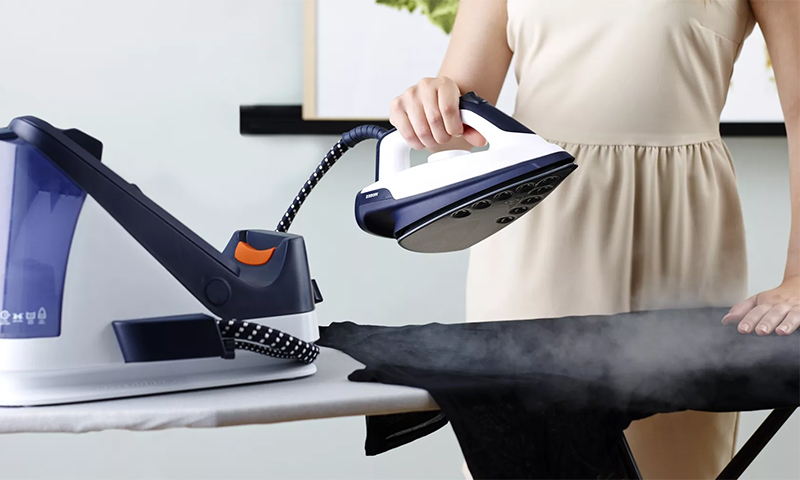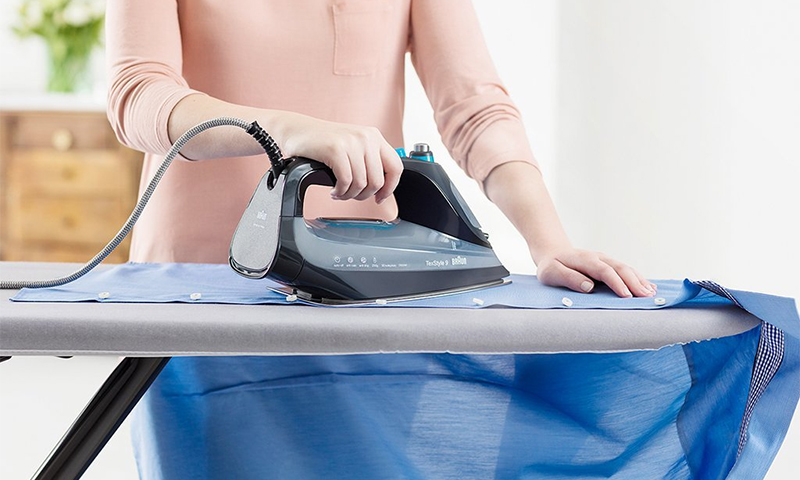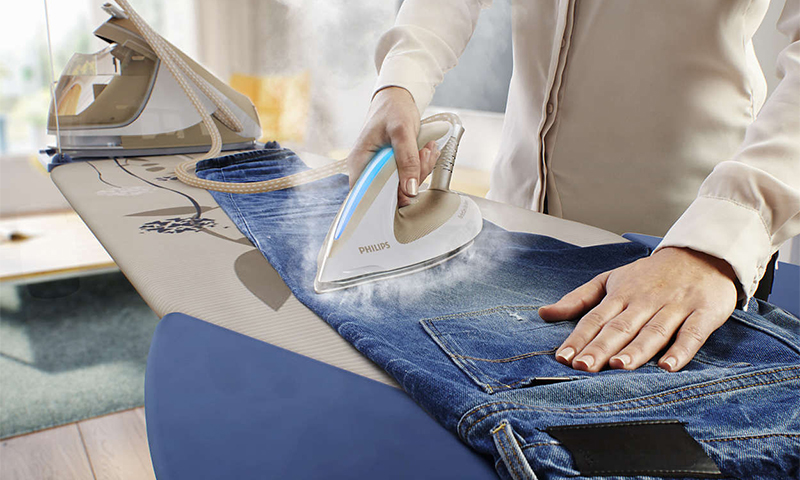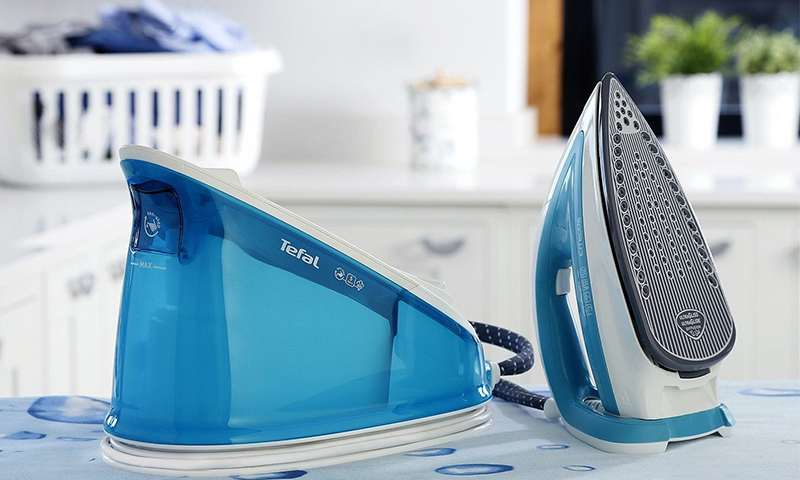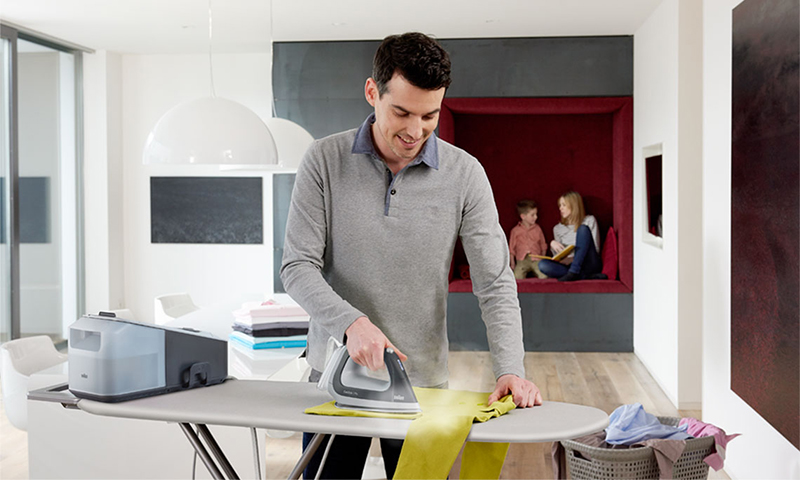To ironing does not turn into a routine and tedious exercise, it is important to choose a comfortable iron that can easily cope with any type of fabric. Modern manufacturers of ironing equipment do not cease to improve their products, adding new and useful features such as self-cleaning, vertical steaming, anti-scale protection and many others. There are even wireless models and “smart” irons, disconnecting themselves from the network, if they are forgotten on the board. To understand the features of such devices and choose the best of them will help our instructions.

Content:
The best manufacturers of irons - which company to choose
Irons of many popular brands are represented on the Russian market, each of which tries to entice buyers with the quality of its products and the innovations being introduced. Among them, there are world leaders covering all price categories, and novice Asians offering high-tech, but affordable devices.
Excellent models for home use, you can easily find in the lines of companies:
- Philips
- Tefal
- Braun
- Vitek
- Polaris
Here You will get acquainted with the best irons of these brands. But to make the right choice, you need to know what characteristics you should look at first.
Principle of operation and device
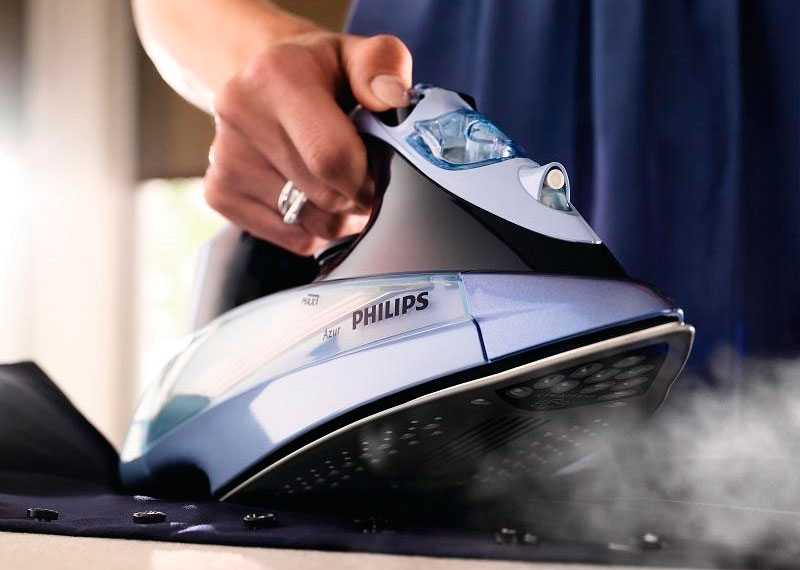
Traditional iron consists of several basic elements:
- housing;
- outsole with a heating element inside;
- thermostat;
- electrical cord (or charging station);
- sprinkling and / or steam injection system.
When you turn on the device in the power grid under the influence of current due to its own high resistance heats the nichrome spiral. She in turn glows the sole. The thermostat (usually a rotary wheel on the body) allows you to change the resistance of the heating element, thereby setting the desired temperature.
Upon reaching the required heating, the bimetallic plate installed inside is deformed and disconnects the chain, preventing the iron from overheating. But its thick sole retains heat for a long time, which makes it possible to continue ironing quietly. And as soon as its temperature drops, and the plate again closes the circuit, the device will quickly begin to heat up again.
A sprinkler or steamer is used to irrigate heavily wrinkled clothes. In the body of the iron for this, manufacturers provide for a special tank into which purified water is poured. When the button is pressed under the pressure of the piston, it is sprayed out of the holes in the sole or is fed through the heating element, immediately turning into steam.
Such a simple principle of operation is typical for most household irons. More advanced models are complemented by a dozen sensors, indicators and various electronic components that extend the functionality of the technology.
Types of irons
Depending on the main characteristics (power, weight, connection method), irons can be divided into several types. To understand what kind of unit will suit you, consider in detail all the pros and cons of each type.
Ordinary iron
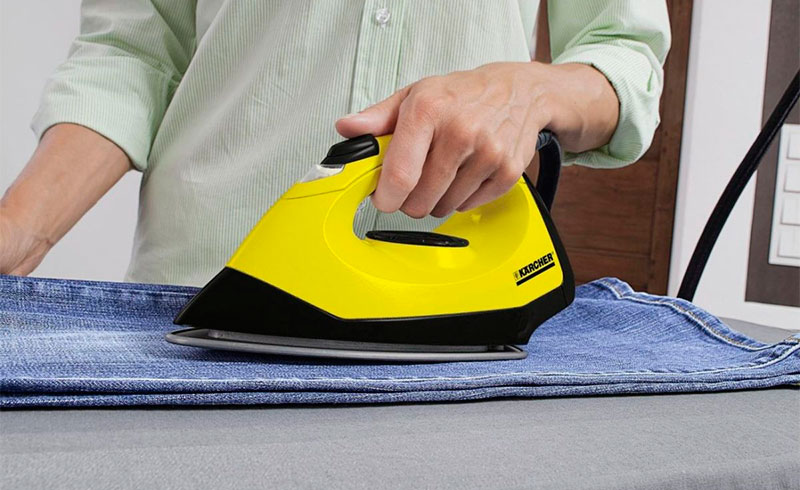
This type of device is designed for ironing synthetic and mixed loose fabrics. Now such units are not very popular, but they are cheap and therefore are still being manufactured by some factories. They can have a pump sprayer or even go without this simplest function.
In addition to the affordable price and more or less tolerable ironing of most things, they have no other advantages. The only thing that can somehow improve the quality of their work is a lot of weight.And if there is enough money only for such a model, choose the one that is harder.
With steam system
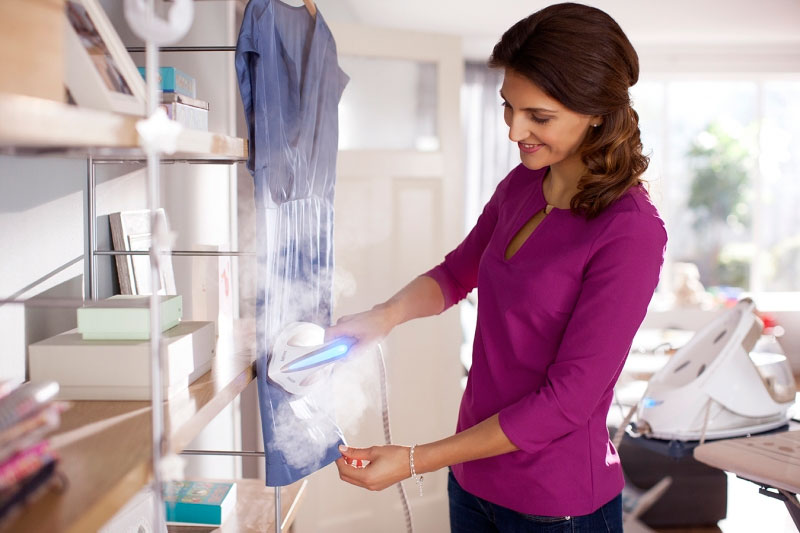
This is a more common technique, presented in all price categories. It is on steam irons that all manufacturers rely, trying to offer the buyer the most “advanced” model. The principle of operation here is no different from conventional devices, but due to the functions of the steaming, the efficiency is significantly increased.
The steam supply can be carried out by gravity, with the vertical position of the sole (if you need to gently smooth the thing hanging on the shoulders) or under pressure - this is the so-called steam blow.
Pros:
- Good functionality;
- Relatively light weight;
- Copes with ironing any type of fabric;
- You can iron delicate and richly decorated things right on the hanger;
- Vertical steaming is easy to freshen and disinfect soft toys, curtains.
Minuses:
- The steam channels on the sole can become clogged with scale if you pour in untreated water;
- At the end of ironing the remaining liquid from the tank must be poured.
Travel Iron
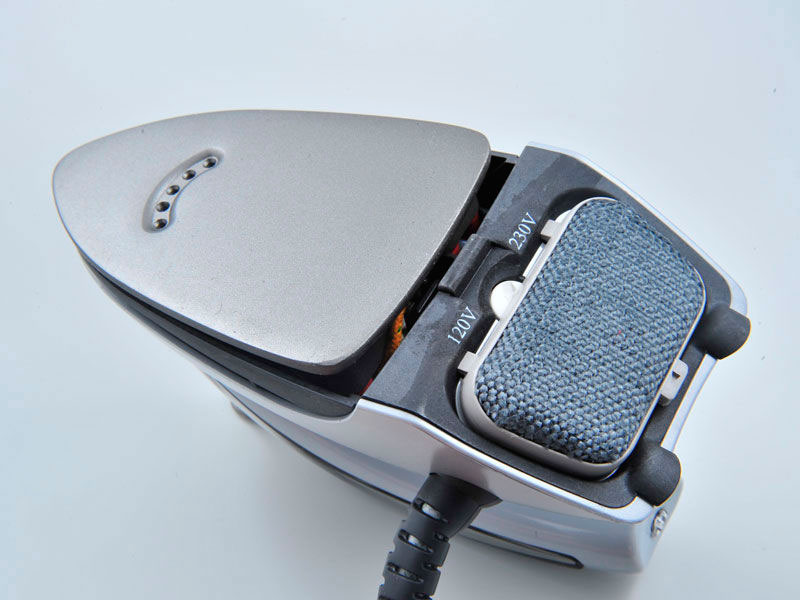
A special case - compact and lightweight devices that can be taken on a trip. Such models are not functionally different from ordinary irons, although among them there are often instances with the possibility of steaming.
Another feature of road irons (except for modest dimensions) - the presence of a removable handle and a special cover for easy transportation and storage.
Pros:
- Small size and weight up to 1 kg;
- All standard set of necessary functions;
- Convenience ironing small items of clothing and difficult areas.
Minuses:
- Small power, not exceeding 1500 watts;
- A trimmed set of temperature regimes (up to 4).
Wireless
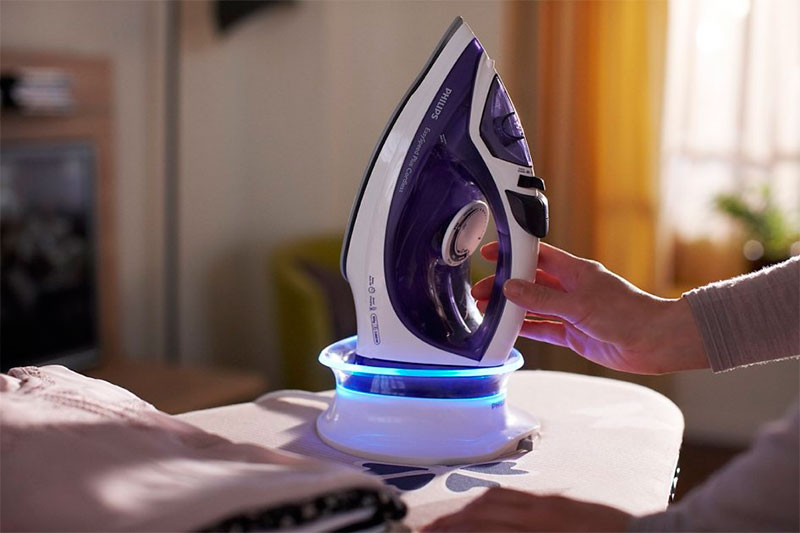
Externally, these irons are no different from wired, but they heat up a little differently. The device is installed on the docking station with contacts, but it accumulates not a charge of electricity, but heat.
After the sound alert about the readiness for work or the light indicator is triggered, the iron can be removed from the stand and ironed until the sole has cooled. Depending on the model, this lasts 25–50 seconds, after which the device is put on recharging again - another 4–5 seconds, and it is ready to work again.
An additional battery is installed inside such units, but its task is only to maintain the electronics in operation at the moments of power failure.
Pros:
- The lack of cord gives complete freedom of movement;
- Low weight;
- Good heating rate;
- There are all the useful functions (steam blow, self-cleaning, drop-stop, etc.);
- Some models can work with or without a cord.
Minuses:
- Unusual to put the iron on the stand horizontally;
- Short battery life - you need to iron quickly;
- The average rate of steam supply (usually up to 35 g / min).
Steam station
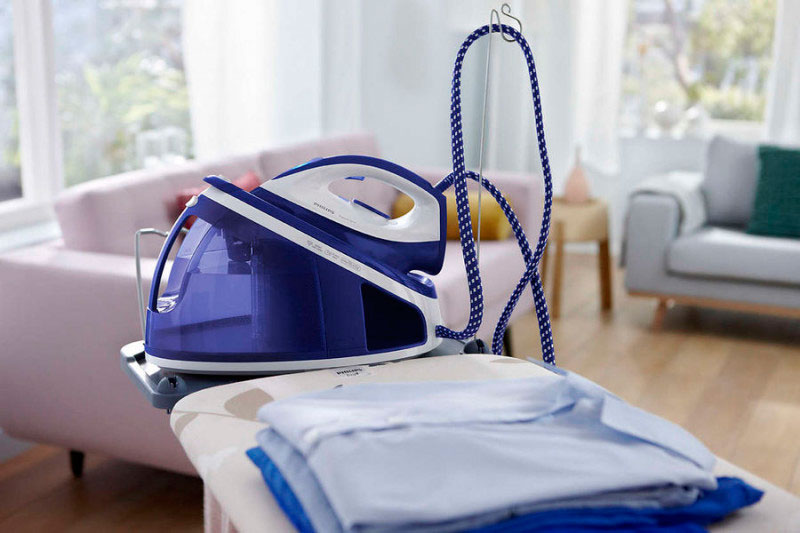
Lightweight and powerful iron, connected through a hose to an external unit with a steam generator. Its tank usually holds at least a liter of water, which allows you to continuously iron clothes up to 2 hours. The outer box is also a stand for the iron itself - as in the wireless models.
Such equipment belongs to the category of professional and is used in sewing shops, studios and laundries, that is, where you need a lot and for a long time to iron things from different materials. The steam power and temperature can be adjusted, which makes it equally effective to iron both drape coats and delicate dresses with rich decor.
Pros:
- Very powerful unit that allows you to quickly smooth over a mountain of things;
- Large water tank;
- The temperature of the sole is lower than that of a conventional iron, which allows working with delicate fabrics;
- Rich functionality, multiplied by the capabilities of the steam generator;
- ECO-mode, reducing power consumption of the device.
Minuses:
- High price;
- The thick connecting hose limits freedom of maneuvering;
- Strict requirements for water quality.
Selection options

To make the right choice, you must first estimate the frequency of use and the amount of linen that you have to iron. You also have to decide on additional features that are useful in your case.
Power
Not only the rate of heating of the iron, but also its energy consumption depends on this indicator. The higher the power, the faster it will heat up to the highest temperature, and then even very wrinkled and dense fabric will easily smooth out.
Devices with a consumption of 1000-1500 W (classic and compact types) will master the ironing of almost any mixed material, but you have to wait a couple of minutes until the sole “accelerates” to the desired temperature. Waiting time is not essential if you have to iron infrequently and a small amount of things. And still it is possible to buy such iron to the country or for the frequent business trips.
Steam aggregates with a consumption of 1500-2000 W can easily iron even very dense and “complex” fabrics like flax. These devices fully cover the needs of any family, reducing the time spent and the time spent on ironing.
More than 2500 watts consume steam stations and professional equipment. Such devices easily cope with a large amount of linen from different types of fabrics. Today, many people use them at home, but this technique is for ateliers and laundries. However, such a limited scope of steam stations dictates only their high price.
Sole
The ease of the ironing process itself, the weight of the device, as well as its cost depend on the material, thickness and coating of the sole.
Aluminum outsole is the cheapest and most common. This metal is a good conductor of heat (it quickly heats up and cools down). Such devices weigh relatively little and at first glide well over the fabric. However, aluminum is easily scratched and can stick to synthetics when it is very hot.
The steel sole is stronger than aluminum, it is not damaged by iron buttons and locks, it has good sliding properties. But such an iron will be much harder and more expensive.
The safest surfaces for ironing delicate items are metal-ceramic, teflon and chrome soles. But they should be treated more carefully than with aluminum ones, since chips and other damages can appear on them.
The best solution would be to use various removable covers, which, if necessary, will protect delicate fabrics and provide them with the most careful ironing.
Modes
Standard irons support at least 3-4 thermal conditions, indicated on the thermostat with different numbers of dots or more understandable inscriptions: delicate fabrics (silk), cotton, wool and linen.
We should also consider the implemented steam supply system - there are also possible options:
- constant steam (20-80 g / min);
- steam blow (over 150 g / min);
- vertical steam.
Also pay attention to the number of steam holes on the sole: the more there are, the more effective ironing will be. It is especially good when there are many such channels on the nose and they are located very close to each other. In this case it will be easier to iron the tucks, the pleats and small details of the clothes.
Additional functions
Here we are talking mainly about those options that simplify the care of the most ironing equipment. They are especially important for models with a steam mode, as poorly purified or too hard water in the tank creates serious problems and may even disable the equipment.
The following options will be useful in a steam iron:
- anti-scale protection;
- self-cleaning;
- anti-drip system.
Auto power off is another useful feature for those who often suffer from the question of whether the iron is turned off. The built-in electronics will de-energize the device itself, left stationary in a vertical position for more than 10 minutes, and already after 1 minute if it is standing horizontally.
Convenience of work
Ironing a large number of things can last for hours, so the iron should not create additional difficulties. Here not only the weight is important, but also the ergonomics of the handle, as well as the length and mobility of the cord.
The first two parameters can be estimated by holding the device in your hands. As for the electric wire, it should be no shorter than 1.5–2.5 m. A swivel fit of the cord at the entrance is welcome and reinforced braiding will save it from twisting and creases.
What iron to choose
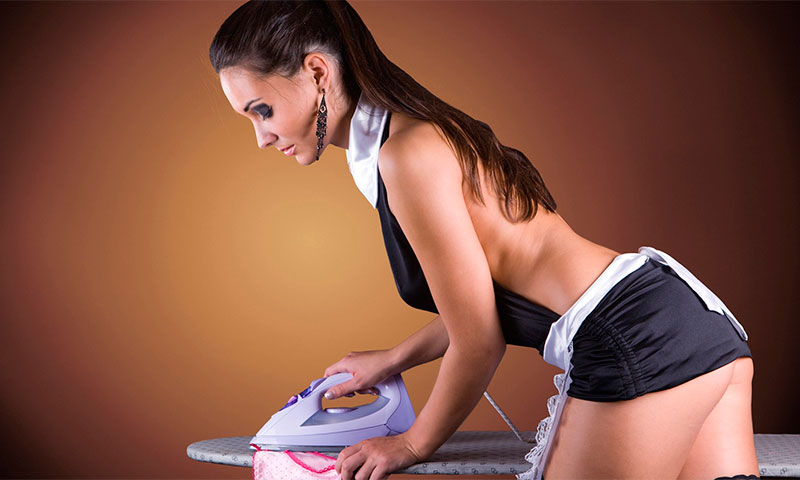
1. Lonely people and students who have ironing limited to a skirt / pants and shirt in the morning will have enough of a small steam iron on an aluminum or steel sole up to 1.5 kW.
2. A family of 3-4 people and all those who weekly iron bales of bed linen after a large wash will need a powerful steam unit of 2 kW with a ceramic or titanium sole, as well as a good set of modes and a self-cleaning function.
3. Dressers, seamstresses, laundry workers - all those for whom ironing is a daily job will need a steam station of good capacity. Ideally, if, in addition to the basic functions, it still has a steam boost mode.
4. For business trips and vacations, it is worthwhile to additionally purchase a compact travel iron with a capacity of up to 1000 watts. The system of steam in it will not be superfluous, especially if you have a lot of summer linen things.
How much does an iron

1. The simplest iron with a spray function can be purchased for 350-1500 rubles.
2. Steam models are a little more expensive: the budget segment is represented by irons of 500–1500 rubles, brand equipment will pull in the amount of 2 to 5 thousand.
3. Good wireless irons can be found at prices ranging from 3,000 to 8,000 rubles.
4. Compact road iron, despite its size, will cost 850-2000 rubles.
5. For a powerful steam station of the Russian assembly will have to pay no less than 2-6 thousand, eminent brands are already priced at 6500 rubles and above.
It will be interesting to friends too

